I’ve been receiving a lot of guest post requests lately on my other website (update: the site has been sold), and I do allow guest posts, but I can hardly accept any.
I reject about 90% of the guest post pitches right from the first email.
I developed enough experience to spot the ones that most likely promise a bad guest post.
And I want to add quality content to my WordPress blog, not low-quality, spun articles.
When I first started allowing guest posts, I was fooled pretty easily. 😄
I accepted a lot of them, and I always ended up spending hours correcting and rephrasing them.
It took me more time to revamp the guest posts than to write them myself.
And I, like the vast majority of bloggers, don’t have time to lose, especially when I’m a one-man army and I have to take care of a huge amount of things each day.
That being said, I thought it’s a good idea to write a guide about what mistakes you’d have to make to get your guest post pitch rejected.
1. Make Grammar and Spelling Mistakes and Typos
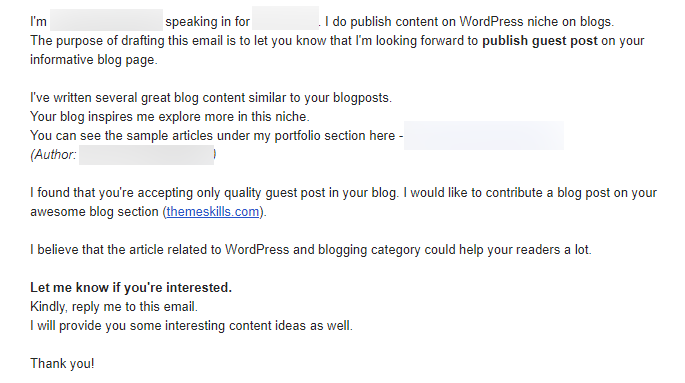
Basically, if you don’t know how to write in English at least at an Upper-Intermediate level, your guest post pitch will most likely be rejected or remain unanswered.
I don’t want to sound like a douche, but that’s the reality.
There’s nothing wrong with not knowing English very well, but in a case like this, it’s vital. At least for quality blogs.
If your outreach email contains poor grammar, poor spelling, poor phrasing, and/or typos, it will be doomed.
Of course, making a typo isn’t the end of the earth, because everyone can make a small mistake.
But if your pitch contains two or more typos, I’ll automatically think that you’re careless and unprofessional, even if your grammar is good.
I’ll think that if you didn’t take the time to carefully write and review your pitch, why would you do that with the guest post?
I’ll probably have to do that, and I don’t have the time nor the patience. And this goes for other bloggers as well, I’m sure.
You could use a tool like Grammarly, sure, but that won’t help with creating articles that need proper phrasing. It just helps with grammar, spelling, and typos.
So, while it might help you to send a simple email, it won’t help you create a quality guest post.
2. Mask Your English Skills
What do I mean by “mask”?
Well, some people write a good guest post pitch, all correct and stuff.
They use a template, or someone else writes the email, or they use Google Translate, which is pretty darn accurate if you write correctly in your own language.
But then, when I receive the actual guest post, I notice that it’s a mess. It happened a couple of times already, and I was really annoyed.
Here’s an example, but the unmasking happened after the second email.

This was the initial mail, which was decent enough for me to reply with a positive answer, at least to see how will it go further.
And then, I got this reply:

So, the first mail was ok, but the second one had 3 mistakes in just a little bit of text.
Unfortunately, I had to reject it. I can only imagine what would’ve awaited me in a 1000-word post.
3. Get the Website’s Name Wrong
I know, I know… I didn’t choose the best name for my other website, which is ThemeSkills, but that’s no excuse for something like this: 😄
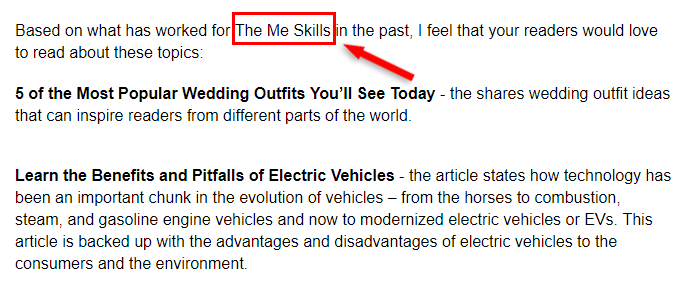
My website’s name can be found in the logo, footer, about page, and at the end of each post/page title. Same goes for almost all websites.
The person who pitched the guest post didn’t even take 5 seconds to search for the website’s name, not to mention its niche.
Because, as you can see, the guest post topics were related to wedding outfits and electric vehicles, which are a bit far from the WordPress niche. 😄
And no, I never wrote about those topics, even if it says: “Based on what has worked for The Me Skills in the past…”. 😄
So, my point is: Always find out the site’s actual name before sending your guest post outreach email. It only takes a few seconds.
If you don’t even care about that, no one will think that you’ll care enough to create a good guest post.
4. Get the Niche Wrong
Since it had two strikes in one email, the above example works here as well.
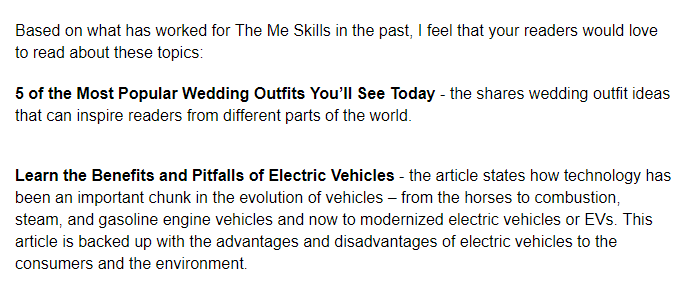
As you can notice, the topics were totally unrelated to my niche, which is WordPress.
So, always find out what’s the niche of the blog before outreaching.
5. Use a Generic Email Address (With Numbers in It)
This happens a lot.
If you are a freelance writer, ok, I understand if you have a standard Gmail address, such as JohnDoe@gmail.com.
But if you say that you represent or are the owner of a company, and you use a generic Gmail address, such as companyname@gmail.com, then my trust level goes all the way down.
First of all, it doesn’t look professional at all. Any decent hosting company allows you to create free webmail addresses for your website.
Secondly, how do I know that you really represent that company or own it if you don’t even have a company email?
So, there’s a serious trust issue there.
What could make it even worse? Numbers!
Numbers in an email address makes it look so spammy and even more unprofessional.
And the more numbers you add, the worse it gets.
6. Say That You’re Constantly Following the Blog and It’s Amazing
While showing interest and praising one’s blog is nice, overdoing isn’t.
Veteran bloggers know it’s bs.

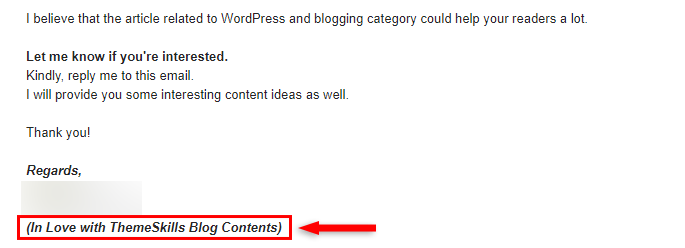
If you’re saying something like this, I know it’s just a standard thing to say and it’s not true, especially if, afterward, you’re recommending topics that are not related to my niche, like this:

I doubt that a regular reader wouldn’t know that I only write about WordPress stuff on ThemeSkills.
Also, by doing this, most bloggers will feel that you’re insulting their intelligence; like you expect them to fall for something like that.
“Oh, I read your marketing blog every single day! I’d like to send you a guest post about ‘How to Properly Feed Horses’, which I believe would be a great fit for your audience!”
Don’t get me wrong.
Saying some nice things about one’s blog isn’t wrong if you’re not overdoing it.
Just go with something simple, such as:
I was doing some research and found your blog. It has some pretty cool articles.
Or, you could check things out and be more specific if you really want to say something nice.
I was doing some research and found your blog. It has some pretty detailed tutorials, especially those about how to create your own server.
It shows that at least you tried to write a better guest post pitch and took some time to check out my blog.
And if I see that you tried and took time to do a bit of research, I’ll also think that you’ll do that with the guest post, hopefully.
7. Use the Same Template
Writing unique guest post pitches can take a lot of time, yes, and it’s not really necessary all the time.
You can have a template if you’re requiring the same thing, but you should add some details that are specific to the blog you’re writing to.
Check the blog and see what’s its name, what’s the niche, what type of content it’s written (tutorials, guides, listicles, etc.), and so on.
Use those details in your pitch to make it more personal, more targeted.
Just by not using the same ol’ standard template could earn you some appreciation.
8. Use a Template and Send Emails in Bulk
If you send guest post emails in bulk, then:
- You can’t make them more personal, as I mentioned above;
- Your emails can end up in Spam, regardless of what email marketing service you’re using.
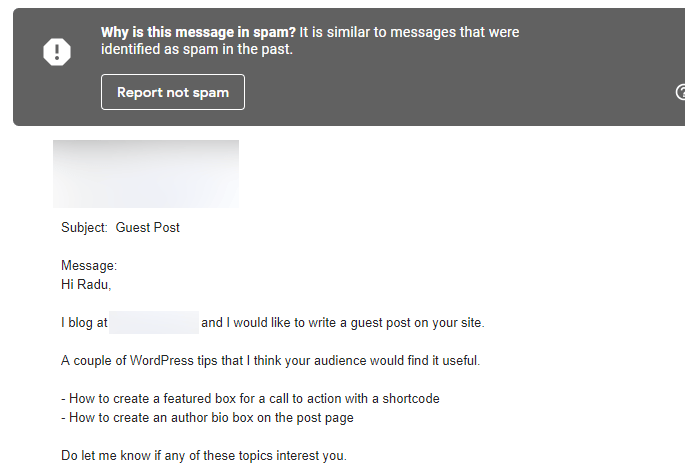
If you use a template and send emails in bulk, your email address will probably get flagged as spam.
I recommend sending the guest post emails manually, one by one, and don’t send too many per day either.
Even if you don’t send them automatically, they can still be treated as spam.
Bonus: Don’t Take No for an Answer
I didn’t add this as number 8 because it happens after the rejection.
In most cases, if you got rejected, it would be best if you wouldn’t ask for an explanation, especially when asked like this:

I normally want to respond to all emails, even if they look like bulk spam.
I know how I felt when I was sending emails and no one answered to them, so I don’t want to be like that.
But in cases like the one above, I tend not to answer.
I just don’t know how to say it nicely, and I don’t want to offend someone by saying: “Your English is bad.” or “Based on your email, I don’t think you’ll do a good job.”.
In some cases, you might even upset some bloggers if you’re being pushy, and they might flag the message as spam.
I got a funny one a couple of days ago in which I was asked to, basically, talk to my superiors and see if they accept the guest post request, because I initially rejected it. 🙂

I am both of them. 😀
Conclusion
I didn’t write this guide as guest post pitching expert.
I wrote it from a blog owner’s perspective, so you can have some insight on how I – and probably many other bloggers – react to different aspects of guest posting requests.
It’s in your interest to write guest post pitches as well as you can because it’s your time and effort invested there.
And besides time and effort, you can also lose great guest posting opportunities due to some mistakes that can easily be avoided. Except for those that are based on English skills.
That’s a Wrap
Hope you found this guide useful and you’ll avoid making these mistakes next time you’re going to write a guest post pitch.
If some info is outdated or incorrect, or you have anything to add, say or ask, please contact me via Twitter or email.
Looking for a modern & optimized presentation website?
Hire me on Fiverr